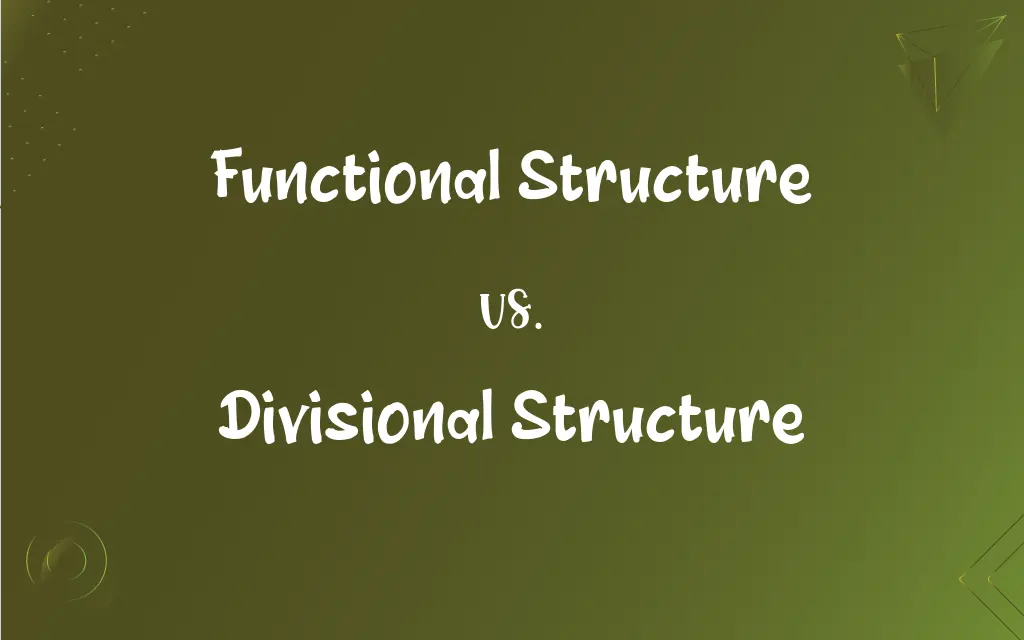Functional Structure vs. Divisional Structure: What's the Difference?
Edited by Janet White || By Harlon Moss || Updated on November 15, 2023
A functional structure organizes a business based on job functions, while a divisional structure organizes it around products, markets, or regions.

Key Differences
A functional structure is an organizational model where employees are grouped based on their roles or functions, resulting in departments like marketing, finance, and HR. In contrast, a divisional structure segments the company based on its product lines, geographical markets, or customer types. Each division operates somewhat independently with its resources.
Within a functional structure, individuals with similar skill sets and expertise are grouped together, promoting operational efficiency and deep specialization. However, the divisional structure provides a level of autonomy to each division, allowing for a faster response to market changes or regional needs. This makes the divisional structure particularly useful for large corporations operating in diverse markets or industries.
One potential drawback of a functional structure is that it can create silos, where communication across functions becomes challenging. In comparison, the divisional structure can lead to duplications as different divisions might have their departments performing similar tasks. Yet, this division-based autonomy can spur innovation and cater better to specific market demands.
When it comes to adaptability, the divisional structure might have an edge as it allows divisions to pivot based on market demands without affecting the entire organization. Conversely, in a functional structure, making organization-wide changes might be more streamlined but slower, given the need to navigate through various function-based hierarchies.
Ultimately, the choice between a functional and divisional structure depends on the company's size, its goals, and the nature of its industry. While startups and SMEs might lean towards a functional structure for its simplicity, larger corporations with diverse product lines might opt for a divisional approach.
ADVERTISEMENT
Comparison Chart
Basis of Organization
Job roles or functions
Products, markets, or regions
Advantages
Promotes specialization, operational efficiency
Quick response to market, autonomy to divisions
Potential Drawbacks
Can create silos, slower adaptability
Possible duplications, decentralized control
Suitability
Often preferred by startups and SMEs
Favored by large corporations with diverse offerings
Communication Flow
Vertical, within the same function
Often both horizontal and vertical, within divisions
ADVERTISEMENT
Functional Structure and Divisional Structure Definitions
Functional Structure
Organized by job roles.
The company adopted a functional structure to group employees by their expertise.
Divisional Structure
Quick adaptability to market changes.
Their divisional structure facilitated a rapid response to the changing market dynamics in Asia.
Functional Structure
May create communication silos.
Despite its benefits, the functional structure sometimes impedes inter-departmental communication.
Divisional Structure
Can lead to resource duplication.
Having a separate HR team for each division in the divisional structure might lead to resource redundancy.
Functional Structure
Promotes deep specialization.
Their functional structure nurtures deep expertise in each domain.
Divisional Structure
Allows autonomy to divisions.
The divisional structure grants each region the freedom to make localized decisions.
Functional Structure
Streamlines organization-wide changes.
Thanks to the functional structure, the new policy was implemented swiftly across all departments.
Divisional Structure
Segmented by products or markets.
The corporation's divisional structure revolves around its three main product lines.
Functional Structure
Based on similar skill sets.
The functional structure brings together individuals with similar skills and knowledge.
Divisional Structure
Suited for diverse product lines.
Given their wide product range, a divisional structure made perfect sense for the multinational company.
FAQs
What are the advantages of a functional structure?
It promotes deep specialization and operational efficiency.
Can a functional structure hinder communication?
Yes, it can sometimes create silos, making cross-functional communication challenging.
What is a functional structure?
A functional structure organizes a company based on job functions or roles.
How is a divisional structure different?
A divisional structure organizes a company around products, markets, or regions.
Why might a company adopt a divisional structure?
To quickly adapt to market changes and grant autonomy to individual divisions.
Which structure is better for startups?
Startups often prefer a functional structure for its simplicity and efficiency.
Why do large corporations lean towards a divisional structure?
To cater to diverse markets, products, or regions with greater autonomy.
Is it challenging to implement organization-wide changes in a divisional structure?
It can be, due to the decentralized nature of the structure.
Does a functional structure facilitate faster decision-making?
It might streamline organization-wide decisions but can be slower in cross-functional scenarios.
Can divisions in a divisional structure operate independently?
Often, yes, divisions have a level of autonomy to cater to their specific market or product needs.
Can a company switch between these structures?
Yes, companies can reorganize based on changing needs, but such transitions require careful planning.
How does the communication flow in a functional structure?
It's mainly vertical, within the same function.
How does a functional structure affect employee growth?
It can nurture deep expertise but might limit exposure to other functions.
In which structure is market adaptability quicker?
Divisional structure, as divisions can pivot based on their specific market needs.
Which structure is more cost-efficient?
It depends. While functional structures avoid resource duplication, divisional structures can be more responsive to market needs.
Do global companies prefer a divisional structure?
Many do, especially if they operate in diverse markets requiring localized strategies.
Which structure promotes innovation better?
Divisional structures might spur innovation by allowing divisions to independently explore novel approaches.
And in a divisional structure?
It's often both horizontal and vertical, primarily within divisions.
Can these structures coexist in a hybrid model?
Yes, some companies adopt a matrix or hybrid structure, combining elements of both.
Is resource duplication a concern in divisional structures?
Yes, different divisions might have separate departments performing similar tasks.
About Author
Written by
Harlon MossHarlon is a seasoned quality moderator and accomplished content writer for Difference Wiki. An alumnus of the prestigious University of California, he earned his degree in Computer Science. Leveraging his academic background, Harlon brings a meticulous and informed perspective to his work, ensuring content accuracy and excellence.
Edited by
Janet WhiteJanet White has been an esteemed writer and blogger for Difference Wiki. Holding a Master's degree in Science and Medical Journalism from the prestigious Boston University, she has consistently demonstrated her expertise and passion for her field. When she's not immersed in her work, Janet relishes her time exercising, delving into a good book, and cherishing moments with friends and family.































































